As a longtime firearms instructor and head of a gun rights group, people ask me all sorts of questions. All questions have merit, especially for people who are new to guns. Among these questions, folks will ask about the safety of shooting old ammunition. I tell them that in general, old factory-loaded ammunition should be perfectly safe to shoot.
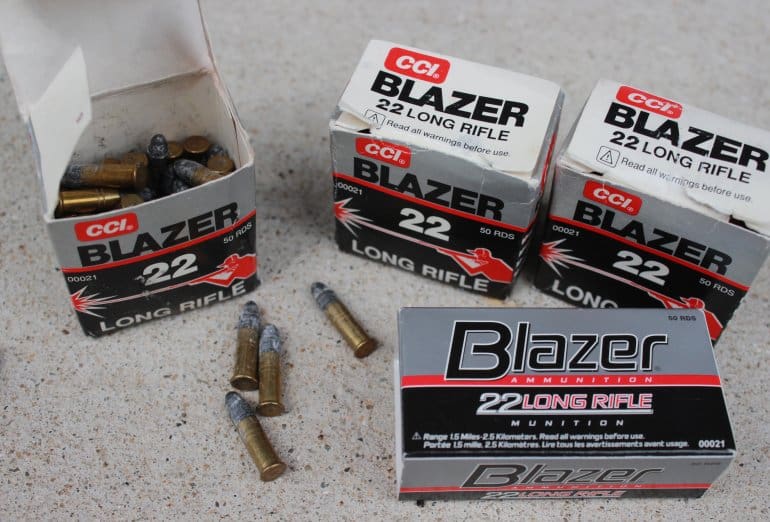
The ammo gods showered me with old ammo recently. A old friend and fellow instructor cleaned out his garage and found several hundred rounds of old .22 Blazer ammo. Yeah, it looks a little rough. At the same time, I’ve shot plenty of old .22s and they usually function pretty well. I wouldn’t use them for a match or competition, but for plinking or skills-building? You bet.
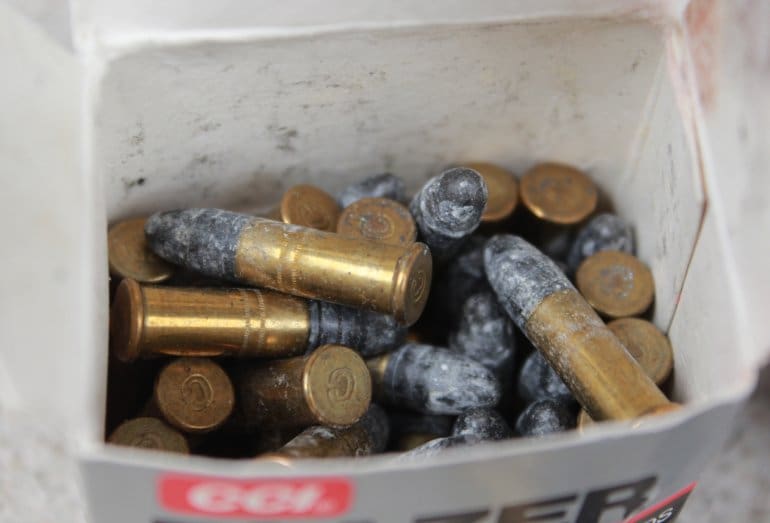
Another friend came upon a massive collection of old shotgun shells at a sale. It was more than he could use so he shared the wealth. In fact, he shared boxes and boxes of shotshells, about a hundred pounds worth.
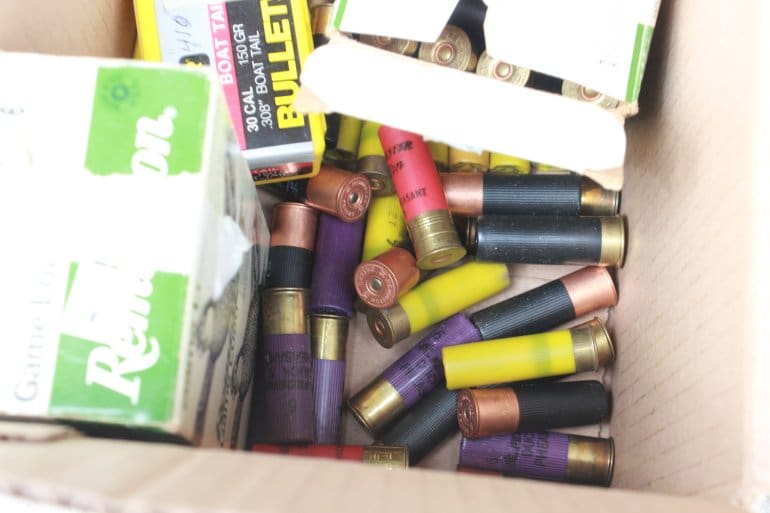
I cheerfully accepted the windfall, as I know old shotgun ammunition also does well, regardless of age. Unless shotgun shells are kept at the bottom of Lake Michigan after an unfortunate boating accident, shotgun ammo tends to forgive owners who store them in less-than-ideal conditions.
If you have old shotgun shells that don’t fire reliably, consider giving them to a reloader to recycle the components. Or sell them to someone you don’t like. Lots of police departments will take unwanted ammunition for disposal, too.
While most experienced shooters will merrily dispose of (that’s spelled s-h-o-o-t) your “old” factory-loaded ammo, I avoid other people’s reloads. You probably should too, unless you know the person who made them and trust them with your health, well-being and fingers.
Shooting someone else’s reloads carries an increased risk of problems. People with attention deficit disorder sometimes don’t make good reloaders. I’ve “inherited” reloads on a number of occasions in my life. Today, I pass them on to other reloaders to recycle the components. Those folks will usually discard the powder (it makes great garden fertilizer) and sometimes the primers, and then reload the cases with fresh, known powder and the original bullet.
Why don’t I like reloads? In short, squibs. Squibs happen when the person or machine fabricating the cartridge failed to include a powder charge in the round. The primer will push the bullet into the barrel, where it will remain remain. If the squib goes undetected and a shooter then fires the next round into a now-obstructed barrel, bad things will happen. It can result in serious injury to both the gun and shooter.
I have shot over 200,000 rounds in my life and the only squibs I’ve experienced came while shooting the home-rolled stuff. Specifically, they all came from old folks who should have stopped reloading long before they finally did.
In the last instance, the man failed to charge every third or fourth round with powder. I used a handful of them to make a malfunction video to show our students exactly what a squib load looks, feels and sounds like. And then I discarded the rest.
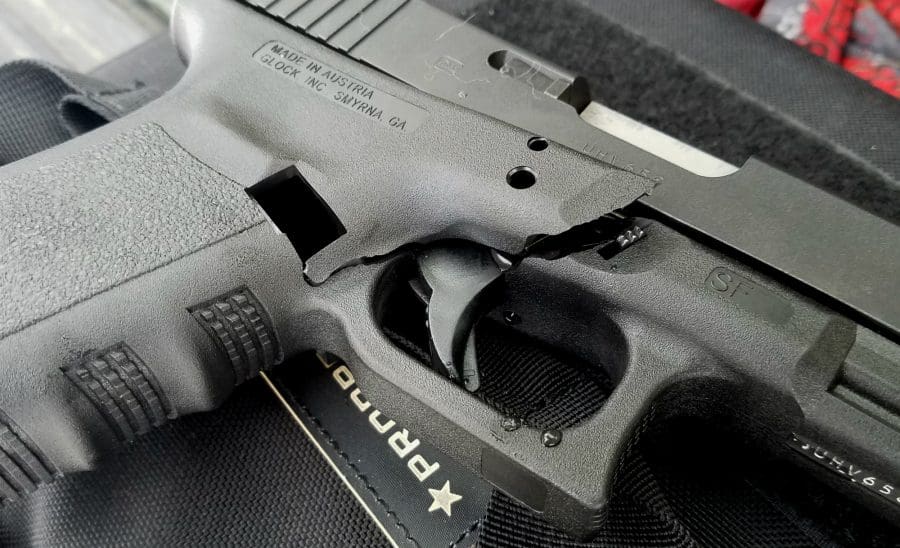
Unfortunately, squibs can wreck your barrel and potentially your firearm as well. Barrel obstructions almost always destroy shotgun barrels, sometimes causing injuries, too. A barrel obstruction in a high-powered rifle can cause a sudden and catastrophic disassembly of the receiver and chamber and damage to all things nearby – including the shooter’s hands, arms and face.
Conversely, if a reloader double-charged the powder in a shell, that can also cause an unwanted, rapid discombobulation of things in your gun.
If you suspect you’ve inherited reloads, my advice remains to pass them on to a reloader for the components. How do you identify reloads? First off, rimfire ammunition is virtually always factory made.
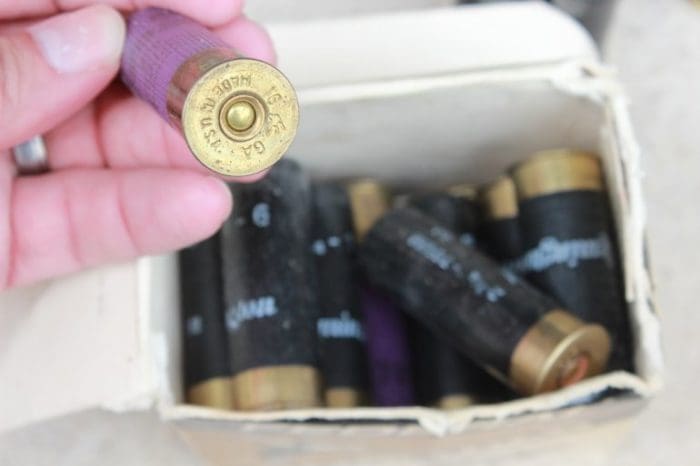
With American-made centerfire rifle and pistol rounds and shotgun shells, factory boxes usually serve as a good clue. At the same time, one must inspect the individual shells in each box. Do they all share the same headstamps and color (nickel vs. brass)? Are the primers of uniform color? Are they all the same gauge or caliber (see above).
Do the headstamps match the box? For instance, do the headstamps say Winchester in the Winchester box? Or do you have Remington rounds in a CCI or Fiocchi box?
If everything looks consistent and the case headstamps are uniform and match the brand on the box, the ammo is probably factory loaded. Furthermore, if the cartridges lack scratches, or other signs they have been loaded, fired or all of the above, that also suggests factory ammo.
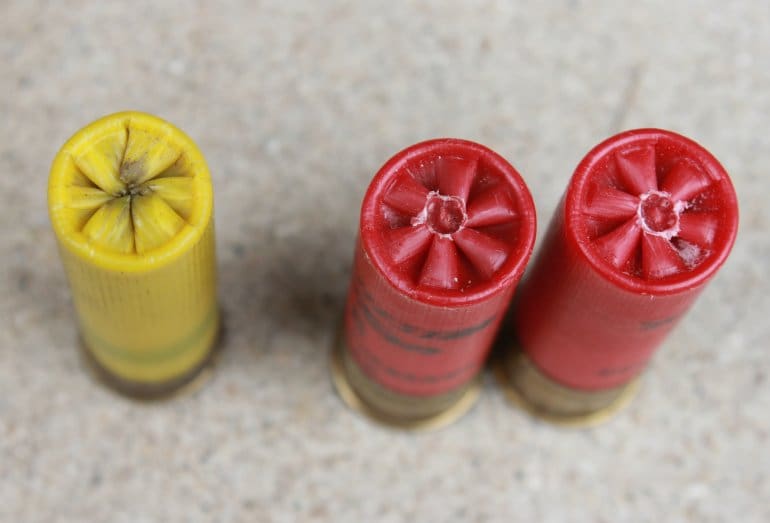
In shotgun shells, do the shells all share the same color and print on the sides? Is the brass base of the shells uniform in height? Do the shells all appear to be factory crimped? If so, that points to factory ammo. Watch for any shells that look like they’ve already been fired and then reloaded (and re-crimped) like the shell on the left above.
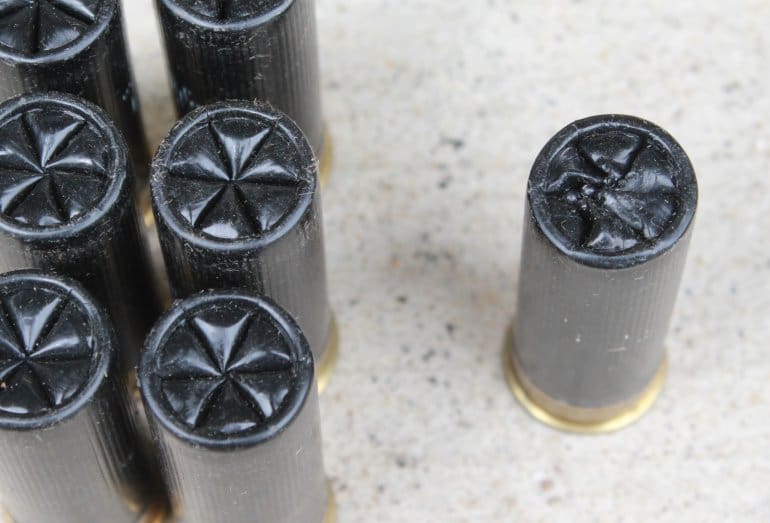
Any rounds that show signs of tampering like the 12-gauge shell above, right should find their way into the trash.
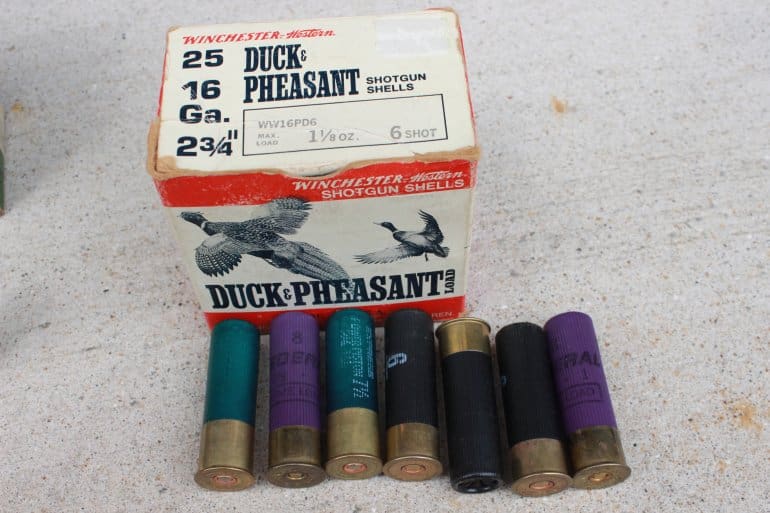
With all ammunition, all manner of shells can find their way into a box. Compare the shells for consistency – and gauge. If in doubt, pass on them. Or at the very least, organize them. Don’t feed 16-gauge shells into your 12-gauge shotgun.
I mentioned American-made ammo above. Old foreign ammo will also shoot in modern firearms of the appropriate caliber. However, some old foreign ammo may prove corrosive to some degree. For those who clean their gun before the sun sets, no problem. For others, like me, you may find a light patina of rust on your barrel two weeks later. Lesson learned.
Remember, if you encounter old ammunition, do not use it for self-defense unless you have no other ammo available. Don’t buy someone’s old ammo to protect yourself and your family. Even if you find some old .357 Magnum hollow-points.
Storing your ammo
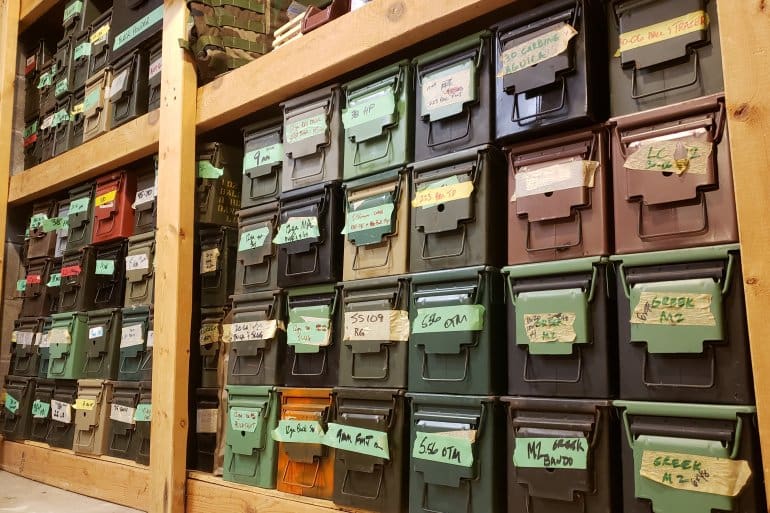
When buying ammunition, American or otherwise, you should store it in air-tight containers. Military surplus ammo cans make great ammo storage containers for your ammo boxes. Regardless of container type, label the outside of the container, too. You’ll thank yourself later.
For those who have more than a few rounds, ammunition cans make great organizers as well. Ideally, keep your ammo cans stored in a cool, dry place.
If you have an impressive ammo fort, don’t stack it too tall and deep if there’s a conventional wood floor underneath. Excessive weight, like numerous cases of 7.62×51 NATO, 5.56×45 (.223), 9mm Luger, .45 ACP and .38 Special can cause floor joists to sag over time. Ask me how I know.
In general, old factory-loaded ammo typically will retain its functionality for a long, long time. Yes, even if it doesn’t look pretty on the outside. One may encounter a few duds with really old or poorly-stored ammo, but by and large, it will go bang every time. To stay extra safe though, try to avoid reloaded ammo to reduce dangers from someone else’s home-made mistakes.

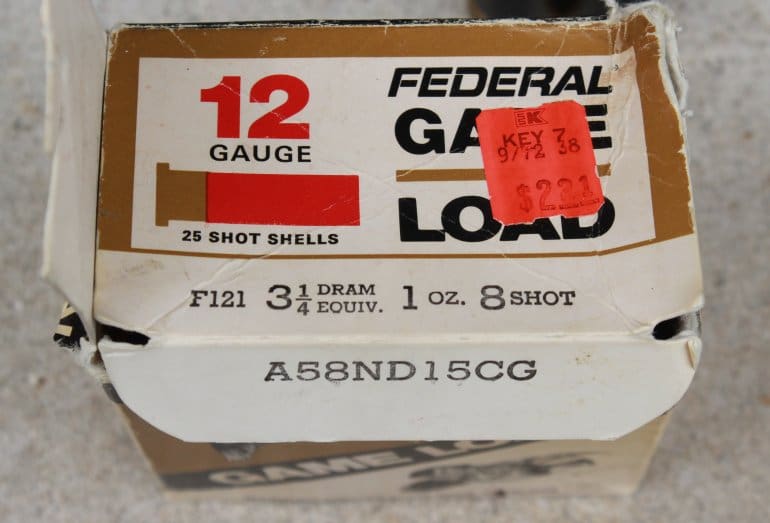



Everything that the story says is false, old ammunition is exceptionally dangerous to shoot in any conventional firearms !!!
Fortunately, I have a blast chamber built on my property that is designed to withstand up to a 1.25 megaton blast. Contact me directly and I will supply you with the information where to ship it to for safe disposal, free of charge.
A public service mined citizen.
You ain’t just kiddin’, I’ve actually figured it’s more like five megaton, but I derated it for the county permits. Otherwise they would have required that I remove the 1968 Chevy van surrounded by approximately 2800 tires that I built it out of .
Repurpose, Reuse, Recycle… just trying to do my part for Mother.
Recycle every day it’s the TTAG way.
yeah, except for maybe recycled propellant. Back when I first started reloading, I bought an 8# keg of pulldown “4350”. Figuring it was probably DuPont milspec, I loaded for a .243 and 7mm Mag Ruger MkII using IMR published starting loads, 10 of each. Luckily, I chose to start with the 243, because after pulling the trigger on the first round, it took a 2×4 to open the bolt. A week later when I went back to the local reloading /supply shop where I got the powder from, they had a sign on the wall NOT to use it, nor fire any of the listed loaded ammo. I got my $28(!) back for the unused powder plus 2 boxes of their premium loading of each caliber I had loaded, so no harm no foul. Never did find out what the powder actually was, but I’d guess if it happened today they’d be sued into oblivion.
So Peanut Butter, 28 bucks for an 8 pound keg of powder ??? What, you were like eight years old when Mn. achieved Statehood?
“yeah, except for maybe recycled propellant.”
About a year or so back, Scott at ‘Kentucky Ballistics’ found that out the hard way when decided to fire some ‘specialty’ surplus .50 BMG ammo, a unicorn called ‘SLAP’ (Saboted Light Armor Penetrator) ammunition.
The round blew the rifle up, *literally* nearly killing him (nicked neck artery). The quick action of his dad, who fortunately was there when it happened saved his life by telling Scott to ‘stick a thumb in it’ and getting him to an ER without waiting for an ambulance as you see here Scott in describing the incident :
https://www.youtube.com/watch?v=1449kJKxlMQ
The question on Scott’s accident I have is, would the round be safe to fire if it were to be be reloaded with modern, known high-quality gunpowder?
Geoff was it even legit surplus slap ammo? I remember thinking it looked a bit off but hard to tell from the video (projectile looked like it was set farther into the sabot than the ones I used).
“Geoff was it even legit surplus slap ammo?”
The manufacturer of the gun determined it was a severe overpressure event due to propellant degradation. Backed up by reports of wildly various velocities people experienced. (Which should have been bright-red warning flags on their own.)
I would think a counterfeit projectile would be the easiest to spot, since it sits out in the open, with only the base concealed, but I’m no ammo expert.
I’m still toying with dropping the coin for one of those puppies. The rifle, not that janky ammo…
The only squib I’ve experienced upto this point was with a 9mm Federal round that I bought off the shelf brand new just a week earlier.
My squib moment was a reloaded .357 that I loaded. Missed the powder charge, somehow. The bullet stuck between the forcing cone and the chamber mouth. Locked the gun up tight and had to use a cleaning rod to tamp the bullet back into the chamber to open the gun up.
I have used surplus ammo that I knew to be 60-70 years old. It worked. Just had to be careful about cleaning. Corrosive primers were used because they could store for decades and still work.
I use some old 7.62×39 ammo in my AK M, loaded one at a time and the trigger gets pulled with a twenty foot long string. I know it’s old from the rust pits in some of the steel cases, and near as I can fugure it’s Russian manufactured with ” Lot #0002 ” written on what’s left of the box.
2002! That’s not that old, but it does seem like it has been stored under very poor conditions. I’d run it in an AK or SKS without a second thought (other than the fact that there may be some duds). I’ve run lots of old corrosive 1960s Czech 7.62*54r. It was great, and I cleaned the rifle (Mosin) immediately after each use.
I’ve had 2 squibs on .38sp ammo that I reloaded myself. Like JWM said…
“The bullet stuck between the forcing cone and the chamber mouth. Locked the gun up tight and had to use a cleaning rod to tamp the bullet back into the chamber to open the gun up.”
Yep. That’s what happened to my 642.
I decided to be more meticulous about my reloading after that. Apparently watching TV and using the old school Lee Loader kit at the same time is a bad idea.
Radio yes. Video no! when reloading.
I listen to a Megyn Kelly podcast while reloading because watching her is…distracting.
My only squib to date was self induced, zero powder in a .223 behind a 69gr Sierra bthp. It didn’t budge, and I only knew is was a squib when I broke it down, thought it was a bad primer. Don’t buy other peoples mistakes and own your own. Old powder goes in the garden like John said.
The worse misfire issue I ever had was caused by an LNL AP progressive press. The measure would work loose because of the bushing. Annoying AF. Due to it being .357 mag the roll crip kept the bullets from popping out, just a waste of a primer and a bullet.
Another thing worth mentioning is that some surplus is better than others. DO YOUR RESEARCH. Also look out for green brass. There’s stabilizers in double based powder that can run out and cause issues. This is known when reloading surplus powder, although I’ve seen recalls from Western/Ramshot and Hodgdon before.
I had some 3031 that after 15 years or so corroded the brass.
Power was low too.
Still shooting 30 caliber carbine and7.62-51 ammo from the Korean and Vietnam conflicts. So there is that.
I work as a RSO for a local state owned range. Checking out some brass, I ran across a WCC 43 headstamp. Western Cartridge Company, 30 cal manufactured in 1943.
We were issued 1952 headstamped .50 cal. in 2007.
The age of the ammo doesn’t mean much.
What means something is what that ammo was loaded with and the conditions with which it was stored.
The one case of actual injury I saw was 303 loaded around 1915 fired in around 1990 with visible corrosion between bullet and case . My friends son was firing some and the bolt set back and case brass fragments went over his head. He took a second rifle and continued despite noting greatly variable report and recoil, this time the brass dug in deep into top of head meat and there was profuse bleeding. I examined the ammo and the corrosion had puffed up the bullets and bonded them very well to the case. Externally you could see black and green with a bit of red and the necks puffed out at the worst spots. I guessed that the Lee Enfield has large dirt clearances so the bad ammo chambered but pressure built too quickly and the old cordite might have even detonated at the end of the combustion cycle. To this day if I shout very rough ammo I seat deeper about 0.01” to be sure to crack any corrosion products.
Two weeks ago I fired a bunch of 32 long rimfire. One brand was all dud, the rest were fine. Accurate too.
“One brand was all dud, the rest were fine.”
The brand of the dud ammo, please?
I’d like to avoid buying it in the first place, if at all possible… 🙁
The ammo was loaded maybe 100 years ago. One type very copper color, they all worked, the ones with the H were duds. I think H was Winchester back then. These are expensive, around $4 a round.
My LT called me into his office. He gave me a note with an address and name. Said the woman was a recent widow and had ammunition she wanted disposed of. This was not unusual. Most times it was a mix of half boxes of sporting ammo. This was unusual. Her husband had been on a markmanship team in the military. I forget which branch. The ammo was match grade M-2, 7.62 NATO, and .45 ACP. There was also an ass load of M-1 carbine ammo. She said she was afraid it might explode. It did. One round at the time. Wal-Mart used to call too. Back when they accepted returns on ammo. They wouldn’t resale it. I used to wheel it out by the shopping cart. The department could use very little of it. Sheriff told me to keep the rest. Good days.
Lucky bigger.
My old friend worked as a security guard and they allocated 50 rounds a month and each uniformed was supposed to go qualify once a month, but the guys would just go sign the book. My friend would shoot until it hurt. He became a riot gun trick shot, one hand rack and fire, rack and fire. Etc.
I do believe this one! Yes sir, yes I do.
I certainly hope old emu is good.
A human gave me a bunch of .44 magnum reloads. Not using that in any of my pistuls. Shute it in the .410 H&R Pardner.
It’s amazing the firearms they make to fit possum sized hands. And osprey wings! Feather light triggers for the win(s)!
Paul Harvey once told the story of how a hunter’s hound dog supposedly knocked over his loaded shotgun, setting it off. Luckily, the hunter’s Aladdin Stanley thermal bottle (part number A-944DH) leaped into action, blocking the shotgun blast from connecting with the hunter’s lower leg.
The Stanley, sadly, didn’t survive the blast. The coffee, also sadly, was half-lost into the campground dirt. The other half, now shot-filled, cooled off a lot faster than the advertised 3-days (or whatever; those Stanleys are amazing!). The hunter needed a change of pants, the dog got a “bad boy” scolding for not protecting the trigger, and the gun? The gun was the only thing happy that day. He got to go “pew” and he hit a target! What gun wouldn’t be happy at that?
Next week: Dogs learn to shoot firearms: We don’t need no opposable thumbs!
I thought that you held and fired the gunms with your talons. Put a Cicada in your mouth and fly around going zzzzzzzzbbbzzzzzzzz firing and imagining you are an A10 Warthog.
Dogs will have to get their gunms from the private market because when the FFL runs the NICS the BATFE sees Fido Bluetick and denys the transaction. ATF ain’t gonna let no dog have a gunm.
Never fired any “old” ammo(except in the 1960’s with my dad). My oldest is about 12 years old & all factory loads. I’m a bit of a safety nut so I won’t take any chances…
Oldest ammo I came across was as a kid in the early 1970s. Found a box of shotgun ammo in the garage at the house we were at.
The ammo had paper hulls and the North Carolina humidity swelled them up so bad they wouldn’t even chamber. I could just twist them to pieces, and did… 🙁
I have a few crates of Turkish 8×57 in my ammo storage. 1951. Packaged in bandoliers and clips.
Just remember to clean properly afterwards.
Be sure to check the tips with a magnet if any look odd. 8mm ap is a thing and it drastically outperforms 5.56/7.62 against ceramic armor (marginally worse against steel but well into vehicle armor at that point).
I have sone of that Turkish ammo. Sone years / batches are slightly hot. Shoot in a robust rifle like K-98.
I think the bullets are soft steel jacket with plating and lead core, not steel core /AP.
if you obtain some old, untraceable ammo from estate sales or such, especially shotgun ammo, save it for those shoot, shovel and shut up situations.
“if you obtain some old, untraceable ammo from estate sales or such,…”
~and~
“…save it for those shoot, shovel and shut up situations.”
Thank you for that confession, Mr. Fudd. It sure will come in handy at your trial.
Have a great day! 🙂
2002! That’s not that old, but it does seem like it has been stored under very poor conditions. I’d run it in an AK or SKS without a second thought (other than the fact that there may be some duds). I’ve run lots of old corrosive 1960s Czech 7.62*54r. It was great, and I cleaned the rifle (Mosin) immediately after each use.
Hang fire danger. Reminds me of true story. Robber ties up gas station attendant, bags the smokes and cash, pours gas, the attendant begs him to shoot him so he doesn’t die slow in the fire. Robber puts gun to his head, pulls trigger, clic, looks down bore. Cops struggled with the scene. Turns out the WW1 Luger and ammo had hang fire issues. Keep gun down range, wait a full 20 seconds, eject clear. For 50 cal wait a full minute.
I don’t believe your story, but y’know what? I’ll take it for a happy Independence Day weekend!
Read about that like 20 years ago. Tried to Google – found nothing. It is a damn cheerful story though!
I didn’t read the article. TLDR, you know. But I can answer the question, “Is it safe to pew pew old ammunition?”
Yes. Yes it is. It’s safe for everybody…except for the bad guy you’re shooting it at. He might want to reconsider his life choices.
“It’s safe for everybody…except for the bad guy you’re shooting it at.”
Eh, I’d be inclined to keep the surplus ammo for range use, and use the fresh, new stuff for defense usage.
But that’s just me, you do you. I can’t do terminal dives from high altitudes for tasty fish snacks, like you can… 🙂
$2.21 for 12ga #8
Too young & dumb to know that those were the good Ole days
.22 for 50 cents a box. Those were the days.
25 cents a box of 50 in 1970, I saw at the corner store…
The rounds I carry in my grass-cutting gun are older than I am. My aunt had several boxes of Winchester ammo from the late 50s. I’ve owned t since late 80s. Still have a box and a piece.
The only old ammo I don’t like is paper shotgun shells. Too easy to swell.
But it bio degraded.
The old timers would melt wax and rub it into shells or even shellac them if it was rainy.
Paper hulls might make a comeback, as they biodegrade…
I’ve used ammo that was more than a century old. BP cartridges. Still went bang.
I have a couple boxes of 50-120 that was loaded who knows when. Brass is a little discolored with age, but looks reasonably good. Also have a couple boxes of 56 Spencer from the 1870’s
I’ve shot a few rounds in my Spencer carbine. Worked well.
Only issue I’ve had was with some surplus 30-06 I picked up for cheap at a gun show years back. A couple of misfires. After a couple I broke down the rest and reused the cases and bullets.
A friend of mine got lucky several years ago. Someone gave him some reloads that he found had been double charged. He, like me, weighs any suspect or unknown handloads before using. If the round is light or heavy it gets broken down.
He was lucky he caught the overloads and didn’t fire them.
I’d suggest keeping old potential reloads and stocking up on the stuff to deal with it yourself.
Unless of course you think the price of copper is going to come back down when the bigwigs in the industry say they fear going belly-up due to what they’re afraid will be 10x increases in the price (meaning they can’t sell much because major buyers basically can’t afford it in bulk and can’t use it in smaller amounts).
Massively increasing regulatory costs while simultaneously using government policy across numerous countries to increase demand by several hundred percent has consequences.
But then, I’m also one of those who thinks that all the “interest rates are coming down soon” shit is pure hopium smoke. Nah, more banking chaos will be driven by that. Powell can choose between the dollar and the financial system. He’s clearly made his choice and the financial system ain’t it.
I have decided to get into reloading because of the “coming smoke” I see on the horizon. And try investing in gold or silver. I think the “accelerationists” are winning in this argument.
Se la vie https://discernreport.com/the-worse-it-gets-in-france-the-less-american-corporate-media-is-covering-it-and-we-know-why/
I don’t generally do financial advice but in this case I will say that if you’re investing in precious metals you want to buy physical them from where ever you can find that has the lowest price over spot but also a good reputation. If you don’t hold it, you don’t own it.
The paper market is manipulated to hell and back. The metals desks for the major investment banks have paid stupid amounts in fines repeatedly and don’t care because they still make a metric fuckton of cash on the deals, it’s a cost of doing business for them. That’s not a game you want to play or players you want to bet against.
Investing in metal miners is a whole other thing that requires more knowledge of the commodities markets than is worth discussing here. Get some copies of ValueLine on the companies you’re considering if you want to do that and get to know those markets too.
As for my point about copper:
The brass being used in ammo is mostly “yellow” brass. That’s 70% copper. Some other stuff is down as low as 60% but regardless, the majority is copper.
The current price of copper is about $3.80 these days with a historical max of $5.02. If you take what the industry guys are saying they’re worried about that means the price of a pound of copper goes to ~$38.
That means that 1.3-1.4 pounds of fresh brass now costs $38 just for the copper, before you even make the brass. And you still need a primer and, in most cases, a coated bullet.
1000 rounds of 9mm “yellow” brass is ~9lbs.
9/1.4 = 6.4
6.4 x 38 = 243.2
$243.20 per 1000 rounds and that’s just the copper metal before you make it into brass and then make the cases.
[Note] I didn’t bother inserting the calculations for the zinc (or tin) and the fact that it’s a large part of the mass of the brass.
There’s not much need, IMHO, since it’s all a guestimate anyway and you’ll have to factor in shipping costs and whatnot too, so I left the mass as pure copper. That might be a bit of an overestimate but it also might be an underestimate due to the externalities in the market for making brass.
The same factors driving the price of the copper will affect the ability to run the furnace that makes the brass, so… I’m calling it a wash.
Minimum math involved for a 10x increase in just copper cost for brass 243.2-24.3 (new-current) we would see a 218.9 increase per case or 28.8 cent per round increase for more than doubling mass manufactured 9mm………..well if I wasn’t already saving cases.
“If you take what the industry guys are saying they’re worried about that means the price of a pound of copper goes to ~$38.”
If the price spikes over $10 a pound, watch how fast shuttered mines in the US West and Southwest reopen.
The same goes for Canadian and marginal Mexican mines, as well…
Geoff:
You seem to think this is business as normal and that all your normal rules apply. They don’t.
A huge part of the reason for the proposed spike in price is regulatory. Those old mines can’t be opened without being brought into compliance. Biden and Trudeau don’t want them opened, they won’t be.
That’s the point. Demand goes up, supply can’t increase. That’s what the guys running the industry are telling you.
I found a coffee can of old 12-gauge shotgun shells that was a mixed stash of colors and brands. Most of the printing on them was unreadable but from the ones that I could decipher they ranged the whole gamut of possible loads. For practice or a zombie apocalypse they probably would all go bang and in a mad max situation something is better than nothing right? No worries mate.
Hell, I shot FN 303 ammo made in the 1950s. It still fired except that the brass was cracking length wise in a handful of rounds. Did I panic. Nope.
I have shot plenty of surplus Korean war and greek ammunition in my M-1. Stuff from the early 50’s. Worked great. My wife’s grandfather also gave me some old 9mm, from the 50’s and sixities. The absolute best was some Remington green box FMJ’s from the early 50’s. A little smokey but grouped amazingly well. Even the 60’s chinese stuff fired fine it just sucked so far as accuracy went. The last was some 60’s Austrian stuff that was on par with UMC modern stuff. All of it was a bit smokey but no failures at all.
I have a box of old mixed shotgun shells, also with some purple ones. I’ve never had a 16 ga., but I’ve kept them just in case. Hasn’t happened. I probably oughta dispose of them so the daughter doesn’t have to deal with them after I have shed this mortal coil.
I once came into a collection of equipment, components, and ammo, that was used by an old timer who cut a wide swath among the local trap shooters back in the late ’50s to early ’70s. His widow was worried that her younger grandsons might mess with it and get hurt. There was a bunch of old Peters blue paper shells that were reloaded for trap. I checked them all, discarded a few that looked bad, weighed the rest, tested a few in the old JC Higgins Model 20 (heavy steel and walnut pump) and then used them up shooting starlings at the mulberry tree behind the barn at the farm. We had a couple duds. Thoonk, and the shot would sprinkle the grass in front of us while the dead powder would drift away in the breeze. Unload and check the bore, reload, and poof some more feathers. That was a great summer. I’d probably be a bit more circumspect about shooting them now, but I was afflicted with the indestructibility of youth back then. I still have about half of the 10 lb. keg of Hi-Skor that came with that lot, and will likely dispose of it.
Is reloaded ammo reliable for EDC? Or is it just for training and hunting?
Is factory 22LR ammo more or less reliable than home reloaded ammo? Or how about factory semi auto ammo vs home reloaded rounds?
Would you trust home reloads over factory made 9mm???
9mm is probably best off factory for the combination of generally reliable tolerances, availability and cost effectiveness so long as your chosen load works in your firearm. 380 is quickly approaching that status as well. For anything else there is a lot of potential benefit in hand loading especially with revolver cartridges and 10mm.
I’ve never had a reliability problem with any of my reloads–handgun, rifle, or shotgun. I noted above, having a few duds with some really old paper shotshells that were loaded by another, and even those were a few out of the many thousands of reloads I have fired. If you are very meticulous, you shouldn’t have reliability issues that are beyond factory ammo specs. “Meticulous” includes a number of things.
Beyond the economics noted above by SAFE, some folks (more likely to be lawyers or self defense experts) recommend against using reloaded ammo for self defense because of the potential for additional legal scrutiny if you ever have to use it. Did you load “cop killer” bullets? Load them hotter than normal? Of course, the folks that argue this point will also advise against modifying your firearm, using zombie killer loads, discussing your self defense inclinations on the interwebs, etc.
My reloading has been for target and hunting, but that’s mostly a function of time and precision, since I handload each cartridge one at a time for specific results. I enjoy the process. Defense is only a recent concern of mine, and my training and defense ammo is all factory, mostly because of the volume and ease of procurement. If I used a progressive press, it may be different.
It depends upon who the reloader is. I would trust my brother’s reloads for self-defense because I know how cautious he is in his reloading practices.
One pheasant hunt he had some old Sears 12 ga. shotshells in #6 shot. They were plastic hulls but there was a dark ring around the case just above the brass. One shot just kind of went “whoop.” I could see the shot column chase after the bird before it fell short. He pulled the shot and reused it and the cases. I think he pulled the primers too but not sure about that. I had a bunch of the same shells and they worked fine in my single shot H&R. I used them for practice.
I had a whole ammo can of .30 carbine head stamped 43. It shot fine. At 25 and 50 yards it was still very accurate. At 100 yards it was a little bit low, but that may be because I didn’t adjust the sights when moving to 100 yards. It was still consistent for military ammo. That was less than ten years ago. I gave the ammo to my brother when I sold him the carbine.
The argument about the prosecutor or civil plaintiff’s attorney commenting on home loaded ammo may be an urban legend. Masaad Ayoub commented in one of his articles that in all the self-defense cases he has testified in it has never been raised as an issue. It would be very helpful before posting a statement about possible prosecution commenting on self-loaded ammo to actually know of a case where it happened and cite the name of case and the jurisdiction. Without those facts to substantiate the theory, it remains just that. If one has not actually been a witness to a specific instance where that was a factor in the trial it just remains urban legend.
I am sure someone somewhere had it come up but more likely in civil court as it would be a lot of effort to argue it being criminal beyond a reasonable doubt vs something by preponderance of the evidence. I didn’t mention it because I have only ever seen it mentioned in Ayoob’s book or people referencing it
Chris, I would trust my own reloads. Someone else’s, not so much. Simply because I have the records of what is in each batch and box. I look at what I have written on the box, and look in my reloading record. I can tell what powder, bullet, primer, and how many times the brass has been reused.
Meticulous record keeping and absolute accuracy in your measurements and procedures.
Everyone can make money now a days very easily…dd…..I am a full time college student and just w0rking for 3 to 4 hrs a day. Everybody must try this home online job now by just use… This Following Website.—–>>> http://Www.EarnCash7.com
How are these bullshit… Everyone can make Money posts, not moderated and denied as spam. Which is exactly what they are.
I was taught a basic reliability trick for long storage life ammo. First buy sealed printed (drop of coating protects the compound). Next use military powder or powder you know to be very high quality with good stable coatings and uncontaminated (washed at the factory of stray ammonia etc.), then at the end put a coating of paraffin wax at the case to bullet and primer or the whole surface. Don’t fingerprint as the skin salts corrode.
I’ve never seen the need to store ammo for twenty years but maybe now with things as they are it’s something people could do for their children?
Stay away from old rounds that look like they have green crayon melted to them. That’s verdigris (brass rust), which means the case wall has a thin spot or hole. It shows up in improperly stored ammo that got wet or was in a leather holder.
Regarding that 50 cal rifle. I do not like the threaded breech cap. Traditional gun design has overload failures yielding ductile metal , exposing vents, and falling onto an alternate load path. Thus acme threaded cap doesn’t have that.
Look at threaded breech artillery. Typically two diameters interrupted threads, so far far stronger. I would not shoot or be near that design.
When my Grandfather passed 10 years ago, I inherited his small collection of guns and ammo. Except for the first year production High Standard Model B .22LR Pistol, nothing else remarkable in hid collection. When I began looking at the ammo, I found boxes of .22 LR dating back to the 40’s. As he spent his life in Southern Colorado, it’s an arid area. humidity is low, and he kept his guns and ammo in a cool dry place. Only one or two boxes made me hesitate, as there were visible signs of corrosion, but the majority looked fine except for the white oxidation on the lead bullets. The ammo ranged from 40’s, 50’s, 60’s and 70’s by their box artwork. A couple of the really older rare boxes I set aside as research showed collector value.
The rest, I’ve shot up. The majority fired just fine, and I was surprised to find very few failures to fire. Out of almost 2,000 rounds, less than 1% failed to fire.
Gramps only had a couple hundred rounds of 12 ga, and all were 60’s, 70’s production. I’ve shot up most of those too. No failures to fire in any of those shells, and all were bird shot anyway (he loved pheasant hunting).
The point though is, that the conditions in which Ammo is stored, plays a big role in its longevity. Even 80+ year old Rimfire Ammo will last if its stored correctly (Cool, Dry, and Rim down, never on its side. The priming compound can shift if it’s stored on its side).
Over the years, a lot of older Ammo has been handed to me. If it looks like reloads, I break it down for the components.
As I mentioned above, I have firearms in my collection that new ammo is no longer made. So hunting down NOS is the only option if you want to shoot the guns. I have found a couple companies over the years that did make ammo for obsolete guns and bought as much as I could at the time. None of these companies are still in business as far as I know.
Check around and you should be able to find companies that will make brass cases for some of the old BP straight wall rifles. That is what I have done for several of the old Sharps or other rifles. My Spencers have to rely on NOS as does my .44 Henry rimfire. I have had a couple misfires from some of the old rimfires, but not any more than 1% of rounds fired. Since these are in short supply, I do limit use of these rifles.
Never used paper shotshells. I’ve seen them, but not used. I have used full brass 10 gauge shells.
No matter what cartridges you run across, Please either know what to look for with corrosion or water damage, or find someone who does and have them examine the cartridges before attempting to use. If there is any doubt, break them down, give them to someone who can, or give them to the local police/sheriff’s dept. for disposal. And make sure any antique firearm is in proper safe working condition before loading it. Don’t guess. Have a competent gunsmith look at the gun. A few bucks is a good investment compared to a firearm detonating in your face.
I use ammo stored in tightly sealed military ammo boxes in a cool dry area with a constant temperature and have had no problems at the range! How its stored makes a big difference.
To “ Geoff “I’m getting too old for this shit” PR”.
I suggest you buy a model if 50 cal that doesn’t use an Acme thread breech plug.
My concern with a threaded plug is that it doesn’t follow proven design practice of progressive ductile failure until a vent is exposed, then falls on a secondary retention or load path. The nature of a threaded joint is that as it’s overloaded, stress will concentrate at the first thread. Compare this to a threaded artillery breech, typically with two diameters of interrupted thread, which does a much better job of using the material’s strength. That rifle that exploded has a screw on breech, and as the first thread tore the rest followed, no vent was exposed, then the breech cap sheared off two pieces of shrapnel . That is simply a terrible design. Not “fail safe”.
“I suggest you buy a model if 50 cal that doesn’t use an Acme thread breech plug.”
It wasn’t the threading, that’s been debunked. It was a *massive* over-pressure event that detonated that gun. 200,000 PSI, while a standard .50 BMG is what, 55,000 PSI?
Serbu suspects pistol powder was in that SLAP ammo.
Edwin Sarkissian buried the barrel of an RN-50 in *concrete* and fired an armor penetrating round. The breech survived, and he could still unthread the breech cap.
See it for yourself :
https://www.youtube.com/watch?v=PIR4PDlY-g8
Here’s Serbu’s conclusion on the SLAP detonation :
https://www.youtube.com/watch?v=4REiTR2dx98
I commented on the YouTube; I will need to watch again to see if you addressed “transition for deflagration to detonation”. I do not know if the ballistics software could capture an abrupt shift to detonation (as opposed to a basic combustion rate vs pressure and temperature) , but I doubt it does. I believe pressure wave reflection and node is involved so and model would need to include geometry.
But I don’t think we can escape “FMEA”. Every breech design should include the basic “ductile yield, vent exposure, secondary load path “ arrangement. Are these present? If not, insert them in redesign. An acme thread will always concentrate load on the first thread as elastic deformation happens. Perhaps you have arranged a progressive thread profile such that the farthest thread is engaged first! I hereby relinquish rights to this idea to you, as a gesture to safety. Can you design to expose vents? Maybe EDM holes such that as the cap translates the vents line up? Sounds hard. Can you arrange two diameters of thread (like artillery breech) with an interrupted thread to obtain much more material participation?
I humbly submit your existing FMEA is unsatisfactory and wants redesign.
Need more proof? Ask me to design an experiment with you. Need fast transducers.
BTW, did the victim have more of those defective SLAP rounds available for investigation?
I stand by what I wrote. The breech failed due to defect of design. The experiment where the muzzle is plugged with concrete is poor. To do the experiment properly you need fast response pressure data. Pressure vessels burst at different thresholds depending on “rate of rise” or “frequency content”. Have you heard of rifles bursting when loaded with light loads? Basically what is going on is “deflagration transition to detonation”. In other words the rate of combustion and the rate of pressure rise is very very much faster with detonation. A materials textbook gave this example; you approach a plate glass storefront window with a wooden rod, put it in the middle and slowly push. The glass shatters at a certain force. Next you take a tiny steel hammer and place it carefully at the same spot and tap the back with an equally small hammer and the glass shatters. Why? Frequency content. The short duration impulse stressed only the glass material right at the impact waveform. The slow push engaged the entire piece of plate glass. Long ago I walked up to a Czech 122 artillery piece where the Egyptians had stuck an impact fuze round into the muzzle and fired. The barrel was splayed open. My buddy opened the breech, no apparent damage.
The muzzle in concrete will cause very abnormal high pressures. Without instrumentation data we don’t know what pressure. No post test inspection of the hardware (plastic deformation of how much and where, does it match computer model). How strong is concrete in tension (poor). That video is entertainment, not engineering.
Propellant powder is engineered to have progressive burning and the rate of combustion (and associated rate of rise of pressure), is as flat as possible and resistance to detonation is a key attribute. The rifle that blew up failed in an unacceptable manner. Assuming the rifle didn’t have a quality issue (like soft steel), it is defective of design.
The breech should yield, vent, and get stronger. This design principle is present I think in any rifle less than 100 years old of design.
The thing about old ammo and reloads…….you don’t know until you know……you know?
Define “Old”.
Pre WWII stuff may be suspect, especially if it is foreign. Doubly true if it is old British stuff loaded with cordite instead of modern powder.
Why? Does cordite go bad? I haven’t seen that. It does have higher burning temperature so erodes barrels faster.
Yeah, cordite is much less shelf stable than modern double or triple based powders. It can weep over time.
I’ve opened .303 made prior 1910, tbe cordite seemed a bit shrunken. Recoil seemed a bit light so I guessed sone oxidation. Very accurate, no flat primers or difficult extractions.
I am guessing what is not wanted is any nitroglycerin to separate. Fortunately I haven’t seen that.
John – You should have reinforced your floors. A couple of years ago we finally agreed to stay in Illinois and I bought a home that I brought a crew to before we moved in. That prevented what I knew would happen if I didn’t.
In keeping with this article and thread. We are still shooting 30.06 ammo and some .45ACP ammo from WWI and considerable more in these same calibers from WWII. We also infrequently shoot .22 shorts and .410s from the 1930s all without problems.
You know, that picture of the multi level wooden shelf with the stacked top to bottom, side to side ammo cans had me drooling. Then I thought how much fun it would be to have to grab one off the bottom…
Comments are closed.